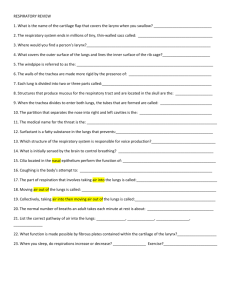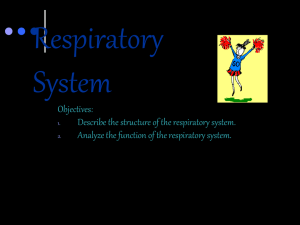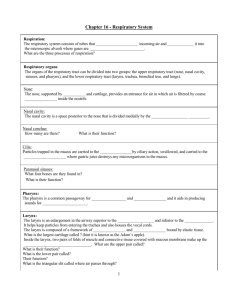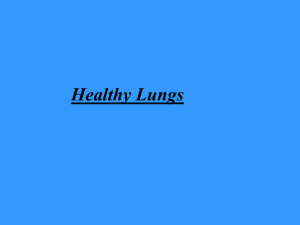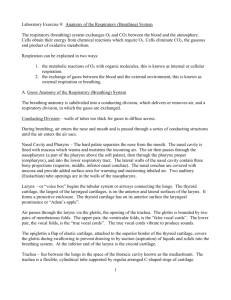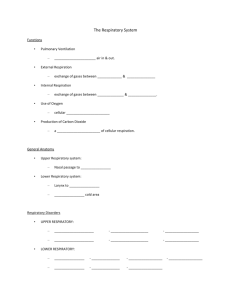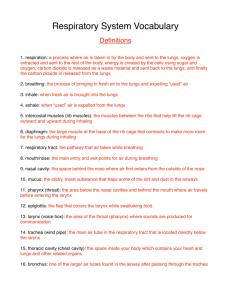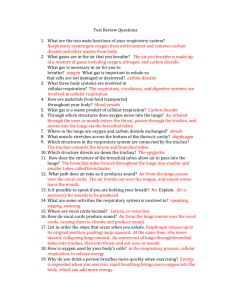Name: Period: Anatomy and Physiology The Respiratory System
advertisement
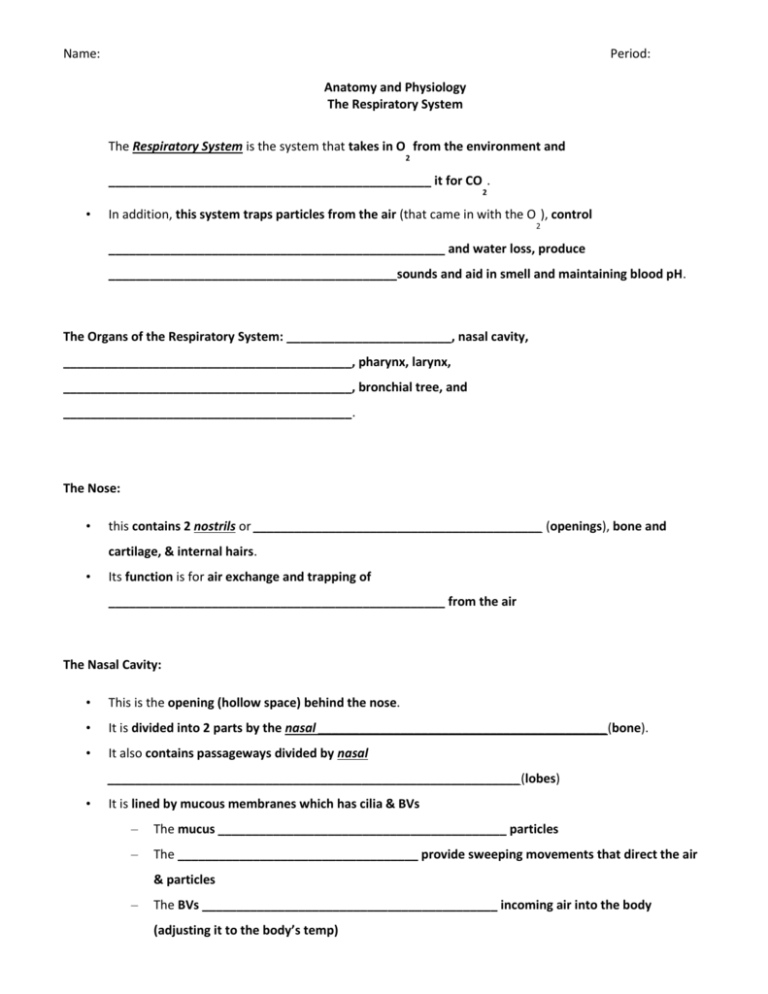
Name: Period: Anatomy and Physiology The Respiratory System The Respiratory System is the system that takes in O from the environment and 2 _______________________________________________ it for CO . 2 • In addition, this system traps particles from the air (that came in with the O ), control 2 _________________________________________________ and water loss, produce __________________________________________sounds and aid in smell and maintaining blood pH. The Organs of the Respiratory System: ________________________, nasal cavity, __________________________________________, pharynx, larynx, __________________________________________, bronchial tree, and __________________________________________. The Nose: • this contains 2 nostrils or __________________________________________ (openings), bone and cartilage, & internal hairs. • Its function is for air exchange and trapping of _________________________________________________ from the air The Nasal Cavity: • This is the opening (hollow space) behind the nose. • It is divided into 2 parts by the nasal __________________________________________(bone). • It also contains passageways divided by nasal ____________________________________________________________(lobes) • It is lined by mucous membranes which has cilia & BVs – The mucus __________________________________________ particles – The ___________________________________ provide sweeping movements that direct the air & particles – The BVs ___________________________________________ incoming air into the body (adjusting it to the body’s temp) Name: Period: The Paranasal Sinuses: • are ________________________________________________ spaces in the skull bones (specifically, frontal, maxillary, ethmoid, & sphenoid) • are lined with _________________________________________ membranes • affect the sound quality of the ______________________________________________ • a sinus headache is (not only painful but) a blocked sinus (it cannot drain properly). This can be caused by ______________________________________________ or infection. The Pharynx: • a.k.a. _________________________________________________________ • passageway for both _____________________________ (leading to esophagus) and __________________________________ (leading to larynx) • aids in sound production The Larynx: • a small passageway that connects the pharynx to the _______________________________________________________ • allows air to pass through, preventing ______________________________________________ from entering the trachea • houses the _____________________________________________________________________ • composed of muscle and cartilage: – thyroid cartilage (a.k.a. __________________________________________________): largest of these; found in the mid-section of the larynx. Do women have Adam’s apples? – epiglottic cartilage: found at the top of the larynx; supports the ___________________________________________________(a flaplike structure that allows air to pass through the trachea but prevents food & liquids to enter) The Trachea: • a.k.a. _____________________________________________________________ • the tube in front of the ___________________________________________________ • splits into the left and right bronchi • contains a ciliated mucoid lining which ____________________________________________air particles and transports air down into the bronchial tree • the wall is lined with ____________________________________________ hyaline cartilage that hold the tube open while the opening of the “C” is supported with muscle which is movable. This allows Name: Period: room for the esophagus to ___________________________________________________ when swallowing. The Bronchial Tree: • _____________________________________________ airways (left & right) that come from the trachea • these are supported by ________________________________________________ until they get smaller & smaller in size (the amount of cartilage decreases with the decrease in size) • these provide the passageway of __________________________________into the lungs From largest (and the trachea) to the lungs: • ______________________________________________move air into bronchioles. • _____________________________________________ move air into alveolar ____________________________________________ then to alveolar __________________________________________then finally alveoli – Alveoli are where gas exchange takes place; _____________________________________________ (a capillary net) are in close contact with these, allowing gases to enter and exit the bloodstream. • Gas exchange occurs here via ________________________________________. The Lungs: • these are soft _________________________________________________ organs that are found within the thoracic cavity • they are enclosed & protected by the _______________________________ and sternum and separated by the mediastinum • they contain: air passages, ____________________________________________, BVs, connective tissue, lymphatic tissue & nerves • the right lung contains _________________ lobes while the left lobe contains ___________________________ lobes. • Each lobe is supplied by a branch of the bronchial tree • Each lung is covered by: – ______________________________________________________ pleura: serous membrane that follows the shape of the lung – Parietal _________________________________________________: serous membrane that covers the visceral pleura – Pleural cavity: potential space in between these; contains small amount of __________________________________________ fluid to reduce friction during breathing Name: Period: Respiratory Physiology • ________________________________________________________ respiration is the use of O by cells 2 (and release of CO ); this is how we produce ATP from food. 2 • Respiration is the exchange of ________________________________________with CO 2 Respiration occurs in 4 steps: 1. ______________________________________________________: breathing in O & out CO (lungs fill 2 2 with air & empty) 2. external respiration: gas exchange between air & ___________________________________________________________ 3. gas transport by blood 4. ________________________________________________________respiration: gas exchange between blood & body cells Breathing Mechanism: • a.k.a. __________________________________________________________________ • occurs by inspiration (breathing in, or ___________________________________________________) and ___________________________________________________ (breathing out, or exhalation) • the pressure on the inside of the lungs is about the same as the pressure on the outside of the thoracic cavity • The __________________________________________________contracts & relaxes, allowing inspiration & expiration. Nonrespiratory Air Movements: • Air movements with the respiratory system for reasons other than ____________________________________________________________________. – This can be ___________________________________________________, sneezing, _____________________________________________, crying, hiccupping, or _____________________________________________. – A hiccup is a _________________________________________ of the diaphragm. – _____________________________________________ is usually to aid the body in taking deep breaths. – These are considered _______________________________________________. Name: Period: – Coughing & sneezing generally clear ___________________________________________________________________ Respiratory Imbalances: • Emphysema is a disease of the lungs in which the alveolar walls ___________________________________________________. • This is a progressive disease that reduces the _______________________________________________ of the alveoli. • This is caused by tobacco smoke, pollution or heredity. • Lung cancer is the abnormal ____________________________________ growth in the lungs. This has a variety of causes, from tobacco to asbestos. This disease metastasizes to major organs and is not treated with much success. Breathing Control: • Breathing is a _____________________________________________ (occurs even when unconscious) • It is rhythmic and ________________________________________________________ • The muscles can be controlled, however • Respiratory Center: – This is a group of neurons found in the brain: pons and _______________________________________________________________________ Control of Respiration: • ____________________________________________ Factors: nonrespiratory movements • ____________________________________________Control: exercise • ____________________________________________ Factors: fear; pain • ____________________________________________Factors: levels of O & CO 2 2

